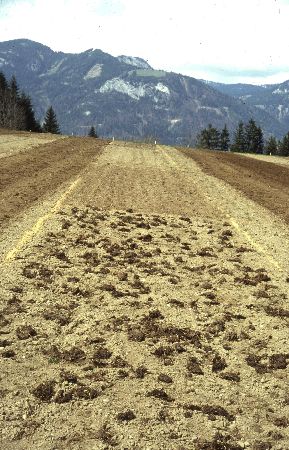The reasons for this were, on the one hand, the specialization of farmers according to the natural conditions in those areas that combine grassland farming and dairy cattle and in the favorable areas that sometimes farm without livestock and specialize in the production of arable crops. In addition, the total mechanization of farmers also played an important role in this decline in arable farming in the Alpine region, whereby the purchase of special machines, which are indispensable in arable farming, is not profitable for rather small-scale cultivation, but is certainly the basic requirement for large areas represents modern management.
The fact that in the beginning at the Federal Institute in Admont various types of grain were cultivated resulted in the implementation of variety trials with different arable crops with the aim of comparing the bred strains with the other, already registered varieties. As a result, the breeding work was stopped, although Austrian breeders continued to show great interest in results about the suitability of their varieties for cultivation in the Alpine region. These documents were also forwarded to the district farmers' chambers, to the consultants (SOLOTAREV-NEKY and HEIN, 1986; HEIN, 1987 - 1990; HEIN and EGGER, 1991 - 1993; HEIN and WASSCHL, 1994 - 2001). Later, direct advice to farmers was added in the form of excursions and field days. Due to the general cost-cutting measures at all federal institutions, variety trials were increasingly restricted over time, which not only reduced the number of trials but also reduced the range of varieties. By outsourcing the Food Agency, the number of variety trials in the extended Alpine region is so severely limited that there is no longer any official testing of varieties for the entire Alpine region. Nevertheless, information about the suitability of varieties for cultivation in certain areas, their susceptibility to disease, their winter hardiness, but also their yield potential in climatically less favorable locations is essential for farmers, because the choice of variety plays an even greater role, especially in these climatically disadvantaged areas than in the favored positions. You also have to keep in mind that the varieties that were bred specifically for the requirements of the dry east are usually not equally well suited to the cooler and wetter conditions of the western parts of the country. Despite all the restrictions on agricultural activities, there are still valleys and basins in the Alpine region in which around 80,000 hectares of crops are cultivated and in which seeds are also produced. The Lungau is one such area, a dry climatic island in the middle of the Alps, where potato seeds can be produced excellently. This basin is also well suited for grain seed propagation because the amount of rainfall during the summer months is not as high here as in the other Alpine valleys.
An important argument that must be included in these considerations is the “national cultural value” of a variety. This criterion, as an important element of variety management, is defined as follows: “A variety has national cultural value if it has the entirety of its value-determining properties compared to the comparable approved varieties 1) an improvement for cultivation, especially taking into account the resistance to harmful organisms, 2) for the utilization of the harvested material or 3) for the utilization of products obtained from the harvested material can be expected" (Austrian descriptive variety list , 2002). Especially in regions that are not so favored by the climate, the national cultural value often plays the decisive role in the use of a particular variety.
As a combination of several business sectors, arable farming in the Alpine region represents one option among many for generating agricultural income. The production of grain in particular enables either direct sales of the grains or processing into bread and baked goods. Potatoes can also be sold from the farm, although those produced organically are certainly easier to market than those produced using conventional methods. Such offers are particularly interesting in the context of tourism if the respective gastronomy is also included. In addition, the component of producing the farm's own feed using silage maize must also be taken into account, which plays an important role, especially in combination with dairy farming. The production of your own feed grain must also be included in these considerations, because the production of straw also has a certain importance in livestock farming. In addition, grassland farms also need arable land that can be used for crop rotation for clover grass or field fodder. For this purpose, business calculations are made that can be carried out based on the data obtained.
The changes in the climate, which are particularly noticeable in the Alpine region, will certainly lead to a long-term change in the cultural landscape (FORMAYER et al., 2001). The already noticeable changes are an increase in the average temperature, a decrease in precipitation in the southern and eastern parts of Austria, and overall a completely different distribution of precipitation than before (STEINACKER, 2001; BMLFUW). Climate researchers are intensively investigating the phenomenon of climate change and are trying to calculate future scenarios for Central Europe and especially for the Alpine region in advance using a wide variety of models (MRASEK, 1999). A decline in cold winters is predicted, as well as an increase in the snowfall limit due to the general rise in temperature. This suggests that in the coming years, arable farming could become interesting again in Alpine areas, especially if water is in short supply in the low-rainfall areas of Austria for the problem-free cultivation of various arable crops. In the last two years in particular, above-average drought in the eastern parts of the country caused severe damage to grain and maize crops. Thanks to the achievements of breeding, it is now possible to bring varieties for rougher locations onto the market. This development has been particularly evident in silage maize over the last 25 years, with more and more varieties with low maturity numbers being entered into the variety list and becoming more widespread in the trade. This enabled silage maize to penetrate into areas that represent so-called climatic border areas for silage maize, but in which very early varieties can achieve a very high yield and which also achieve the appropriate dry matter to produce good silage.
Another argument for agriculture in the Alpine region is the preservation of the diverse forms of the cultural landscape. Traditional elements were the fields used for agricultural purposes in this area as well as the meadows and pastures. Land used for grassland alone does not offer as much biodiversity in flora and fauna as in combination with agriculture. Agriculture has also made a significant contribution to shaping the cultural landscape, which is why the remaining elements should be given appropriate importance.







